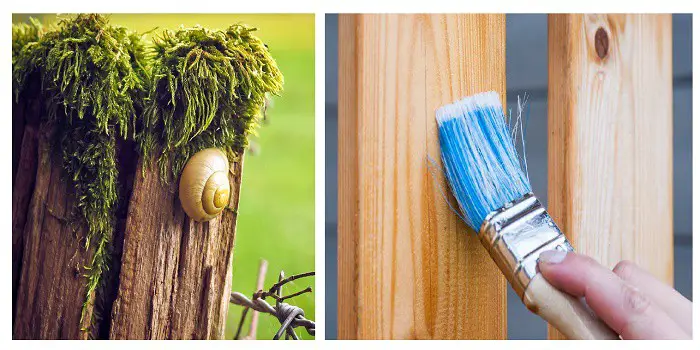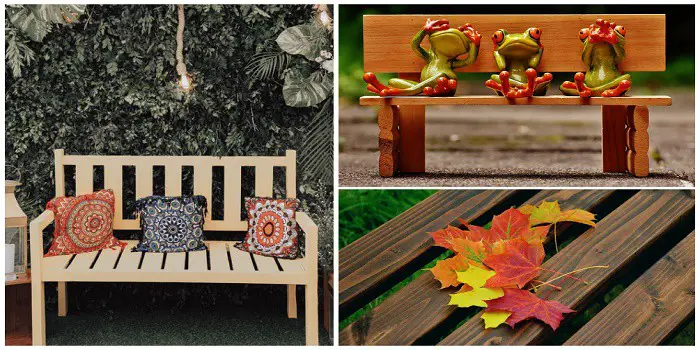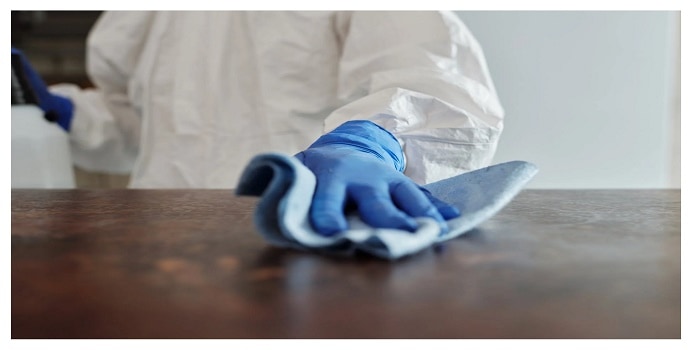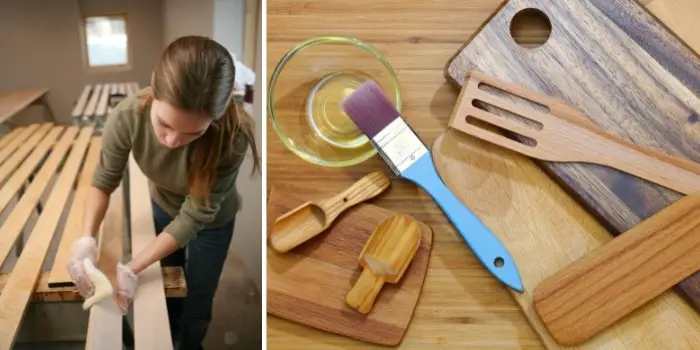
If you’re like most moms, you probably think of mineral oil as something that’s used to treat babies’ bottoms.
But it turns out that this natural, odorless oil has a lot of other uses, too – one of which is preserving and protecting wood furniture.
Mineral oil is a good popular choice for protecting wood furniture and floors simply because it’s non-toxic, easy to apply, and long-lasting.
In this article, we’ll show you how to apply mineral oil to wood using three different methods.
In this blog post, I’ll show you how to apply mineral oil to the wood using different methods so that it looks and feels great for years to come. Let’s get started!
What is Mineral Oil?
Mineral oil is a clear, odorless oil that’s derived from petroleum.
It is made of hydrocarbons, which are molecules consisting of both nitrogen and chlorine.
It’s often used in food preparation and as a laxative, but it also has a number of other uses, including a wood finish.
When applied to wood, mineral oil creates a barrier that helps to protect the wood from water damage, scratches, and other wear and tear.
Since it’s a non-drying oil (it does not harden when exposed to air), it also helps to keep the wood looking shiny and new by preventing it from drying out and cracking.
Using Mineral Oil On Wood
If you have planned to give a makeover to your old worn-out furniture by using mineral oil, I am sure you won’t be disappointed.
There are three different ways that you can apply mineral oil to wood. These include:
1. Using a clean cloth
If you’re using a cloth, simply dip it into the mineral oil and then rub it onto the wood in a circular motion.
Be sure to get into all of the nooks and crannies, and pay special attention to any areas that seem dry or thirsty.
When you’re finished, buff the wood with a clean, dry cloth to remove any excess oil.
2. Using a brush
If you’re using a brush, dip it into the oil and then brush it onto the wood in long, even strokes.
Again, be sure to get into all of the nooks and crannies and pay special attention to any dry or thirsty areas.
When you’re finished, buff the wood with a clean, dry cloth to remove any excess oil.
3. Using a spray bottle
If you’re using a spray bottle, simply fill it with mineral oil and then spritz the wood with a light, even layer of oil.
Spray the oil evenly into all of the corners as well.
When you’re finished, buff the wood with a clean, dry cloth to remove any excess oil.
How long does mineral oil take to dry on wood?
After you have applied the mineral oil to your wooden surfaces, make sure you set your treated wooden items aside to give them enough time to oxidize and harden.
Mineral oil will take a few hours to soak and penetrate the wood completely, and it will take about 24 hours to fully dry and cure.
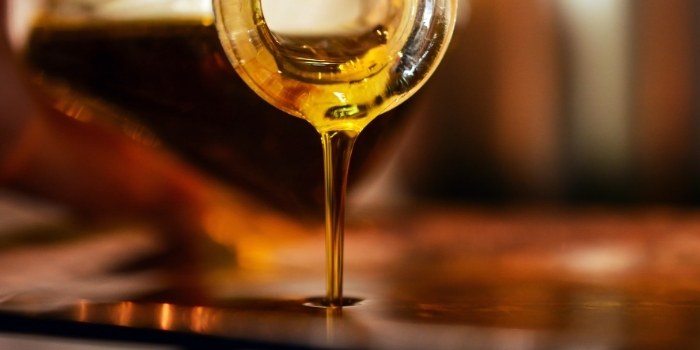
The Pros and Cons of Using Mineral Oil for Wood
Mineral oil is an excellent choice for finishing cutting boards and butcher block countertops because it is food-safe, fills the wood pores in wooden surfaces, and repels the particles of food and liquids.
For wooden baby toys, this clear, odorless, and hypoallergenic finish doesn’t harm your babies even when they put the toys into their mouths.
However, there are a few things to keep in mind when deciding whether or not to use mineral oil on your wood furniture or floors.
Here are some of the pros and cons of using mineral oil:
Pros:
- It’s easy to apply
- It doesn’t require any special equipment or skills to apply
- It helps to keep the wood looking shiny and new
- It’s non-toxic and safe for both people and pets
- It’s long-lasting and can be applied over water-based stains
Cons:
- It can be messy
- It can be difficult to remove if you decide you don’t like it
- Some people prefer not to use petroleum-based products
- It can darken the wood over time
Mineral Oil Alternatives You Can Use for Wood Finish
Due to the challenges mentioned above with applying mineral oil finish on wood, there are instances when you do not want to use it on your wood furniture.
Well. worry not; there are a few good mineral oil alternatives that you can use for wood. These include:
1. Beeswax – it’s a natural wax that’s produced by bees.
2. Linseed oil – it’s a natural oil that’s extracted from flax seeds.
3. Tung oil – it’s a natural oil that’s extracted from the nuts of tung trees.
Besides these most common mineral oil substitutes, walnut oil, coconut oil, olive oil, and avocado oil can apply a protective finish to your wooden floors and furniture.
You can also use a 3-IN-ONE Multi-Purpose Oil safely on wood as it has a petroleum base and is not artificially created. 3-in-One Oil is a kind of general-purpose lubricating oil that’s sold in stores for household and do-it-yourself use.
All these can be used as a wood finish because they are non-toxic and easy to apply.
What are Some Other Uses of Mineral Oil Around the House?
Besides preserving and conditioning the wood in your house (like cabinets, old tables, chairs, cutting boards in the kitchen, and other furniture items), you can use mineral oil in a variety of different other ways.
Some of these applications of mineral oil around the house include:
1- Metal Rust
Use it as an oil to protect the metal from rusting. Simply apply it with a brush to the area you want to protect and let it dry.
You can not only use it on your metal garden/garage tools, but also you can use this method for protecting cast iron skillets.
2- Clothes Stains
If you have tough stains on your clothes, then using mineral oil can be a great way to remove them.
All you need to do is apply some oil to the stain and then rub it in with a brush. After that, you can simply wash the clothes as usual, and the stain should be gone.
3- Fix Squeaky Doors
Have a squeaky door in your house? Mineral oil can help you fix it as well.
Apply some oil on the hinge and then open and close the door a few times. The oil will help lubricate the hinge and make it quiet.
4- Silence Your Creaky Floors
Creaky floors are not only annoying but can also be embarrassing, especially when you have guests over.
To silence them, simply apply some mineral oil to the affected boards, and they will become less squeaky.
5- Keep Ants Away
Ants are not only a nuisance but can also be dangerous, especially if you have young kids or pets in the house.
To keep them away, simply apply some mineral oil to the areas where they usually come from.
The ants will not be able to cross the oil and will be forced to find another way into your house.
6- Remove Stuck Rings
I know how hard it can be to remove a stuck ring, especially if it’s your wedding ring. The good news is that you can use mineral oil to remove it.
Apply some oil to your finger, and the ring should come off easily.
7- Protect Your Skin
If you work with harsh chemicals in your home, garden, or garage, then your skin is probably suffering from the exposure.
To protect your skin, simply apply some mineral oil to the exposed areas before you start working.
It will act as a barrier between your skin and the chemicals.
8- Clean Paintbrushes
If you have just painted your house and there are paintbrushes that are full of dried paint, then mineral oil can help you clean them.
Soak the brushes in some oil, and then use a brush to scrub the bristles. After that, you can wash them with soap and water, and they will be as good as new.
9- Remove Glue and Adhesives
Removing glue or any other adhesive stickers from surfaces can be extremely tough, especially if it’s already dried.
Mineral oil can help you fix that as well. Start by applying some oil to the area and then wait for a few minutes. Afterward, use a cloth to wipe away the adhesive and the oil.
10- Condition Leather
Leather jackets, upholstery, car seats, and other leather items can suffer from wear and tear over time.
To keep them in good condition, you can use mineral oil to condition the leather and make it softer.
Simply apply a layer of oil to the leather and then rub it with a brush.
After that, you can wipe away the excess oil, and your leather will be softer and more conditioned.
11- Clean Stainless Steel Appliances and Utensils
A dirty kitchen with stainless steel appliances and utensils can be tough to clean.
But if you use mineral oil, the job will be much easier.
Apply a layer of food-safe mineral oil on the surface and then rub it in with a cloth. Next, wipe away the oil, and your kitchen stuff will be clean and shiny.
12- Diffuse Oil with Other Essential Oils
Who doesn’t love the smell of essential oils? If you want to diffuse your favorite lavender or lemon grass EOs in the air, then mineral oil can help you do that.
Simply add a few drops of essential oil to a cotton ball and then add a drop or two of mineral oil. After that, put the cotton ball in a diffuser and turn it on.
The essential oil will be diffused into the air, and your home will smell great.
13- Use It as a Makeup Remover
Removing your makeup without using harsh chemicals can be a real challenge.
But worry, not mineral oil is a great way to do that.
Start by applying some oil on a cotton ball and then gently rubbing it over your makeup.
After that, use a clean cloth to remove the oil, and your makeup will be gone.
FAQs
Does mineral oil change the color of wood?
Mineral oil adds volume to the grain and improves the natural color of the wood, giving it a better appearance.
Just bear in mind that this finish will not endure forever and must be reapplied on a regular basis to maintain the attractiveness and integrity of the wood.
How often should you apply mineral oil?
It’s a good idea to apply a fresh layer of mineral oil to your wood furniture and floors every few months.
This will help to keep the wood looking its best and prevent it from drying out, cracking, or becoming damaged.
How do you remove mineral oil from wood?
If you decide that you don’t like the look of mineral oil on your wood furniture or floors, don’t worry – it’s easy to remove!
Simply soak a clean cloth in some citric solvent or odorless mineral spirits and then rub it onto the wood in a circular motion.
Let the solvent sit for a few minutes, and then wipe it away with a clean, dry cloth. Repeat this process until the entire mineral oil has been removed from the wood.
Final Thoughts
There are a few different ways that you can apply mineral oil to wood. You can use a clean cloth, a brush, or even a spray bottle.
The most important thing is to ensure that you’re applying a thin, even layer of oil to the wood. You don’t want to saturate the wood or leave any drips or puddles of oil behind.

Hi, I am Mark Garner a professional carpenter, woodworker, and DIY painter. I live in the small city of Peoria, Arizona as a semi-retired woodworker. I have started this blog with a simple motive to help you with my wood experience in this sector. If you like to know more about what I love doing and how it all got started, you can check more about me here.

